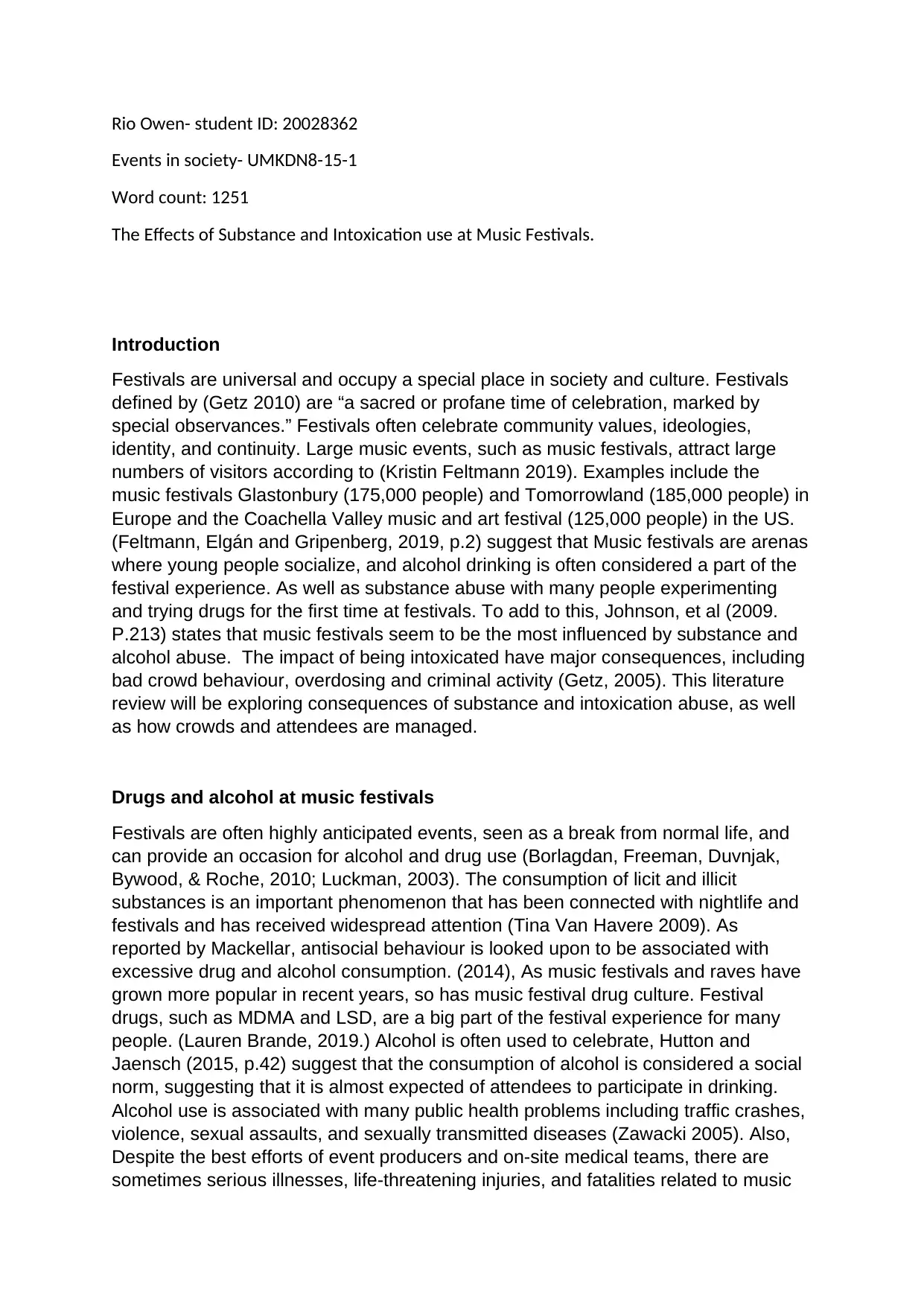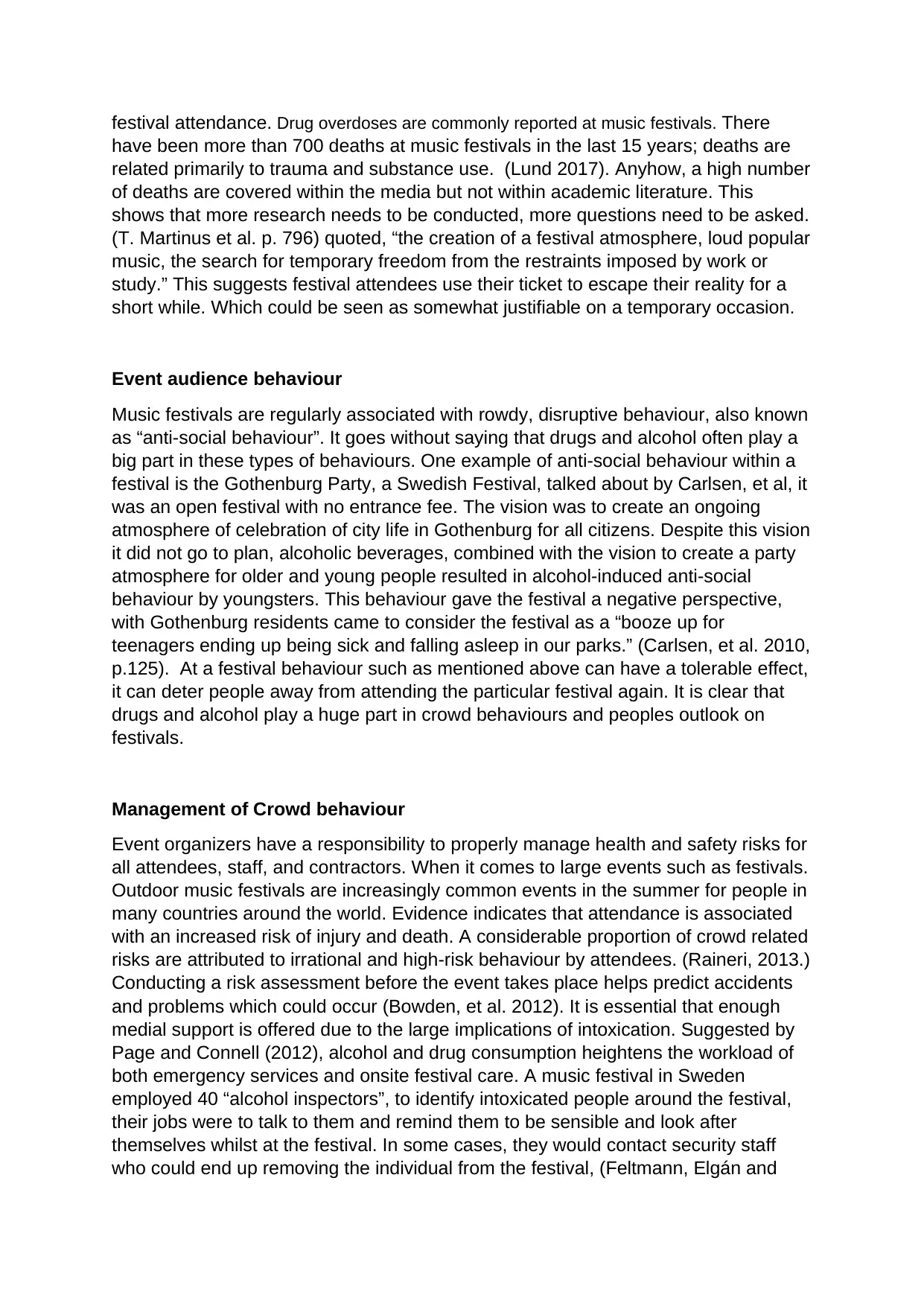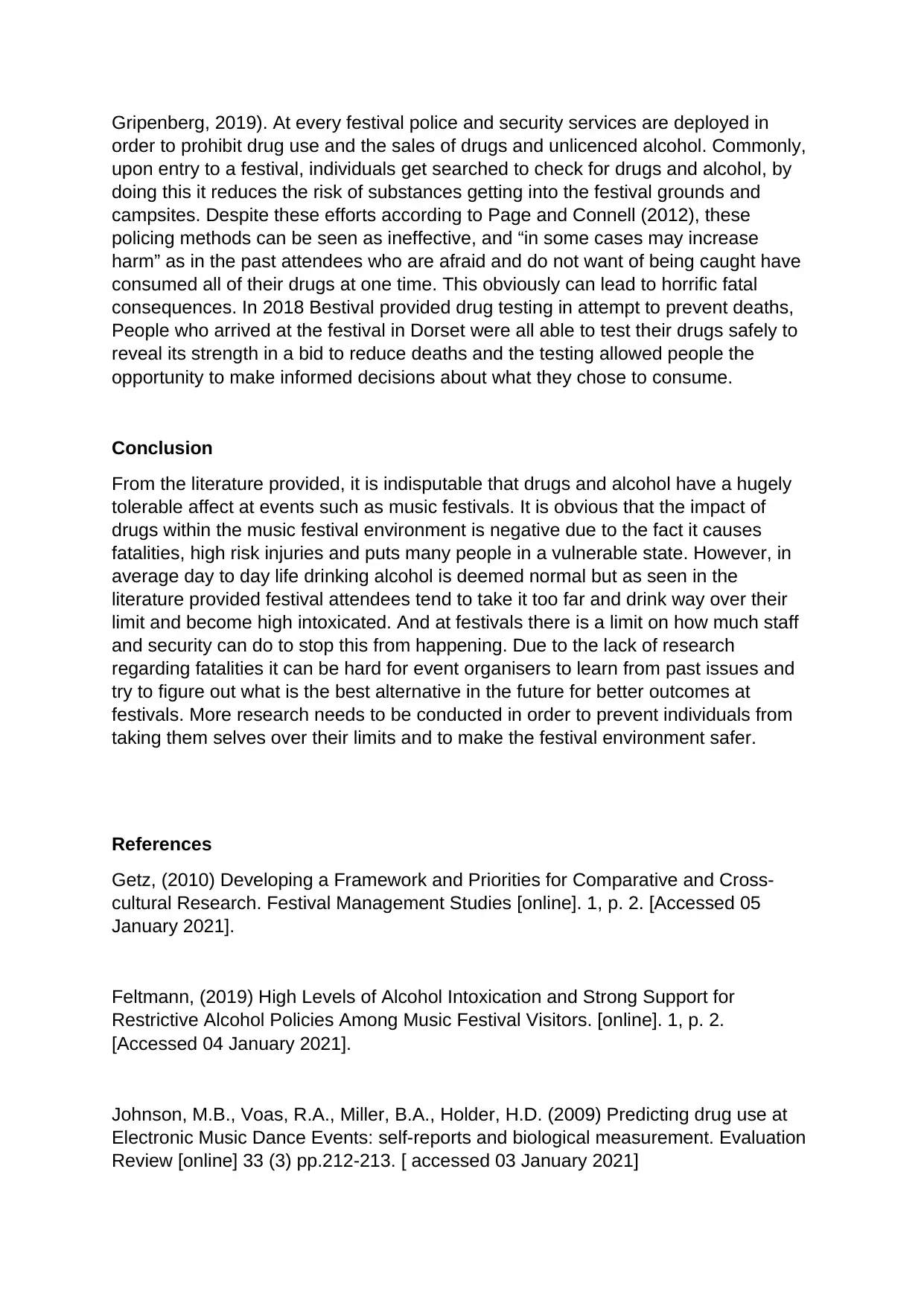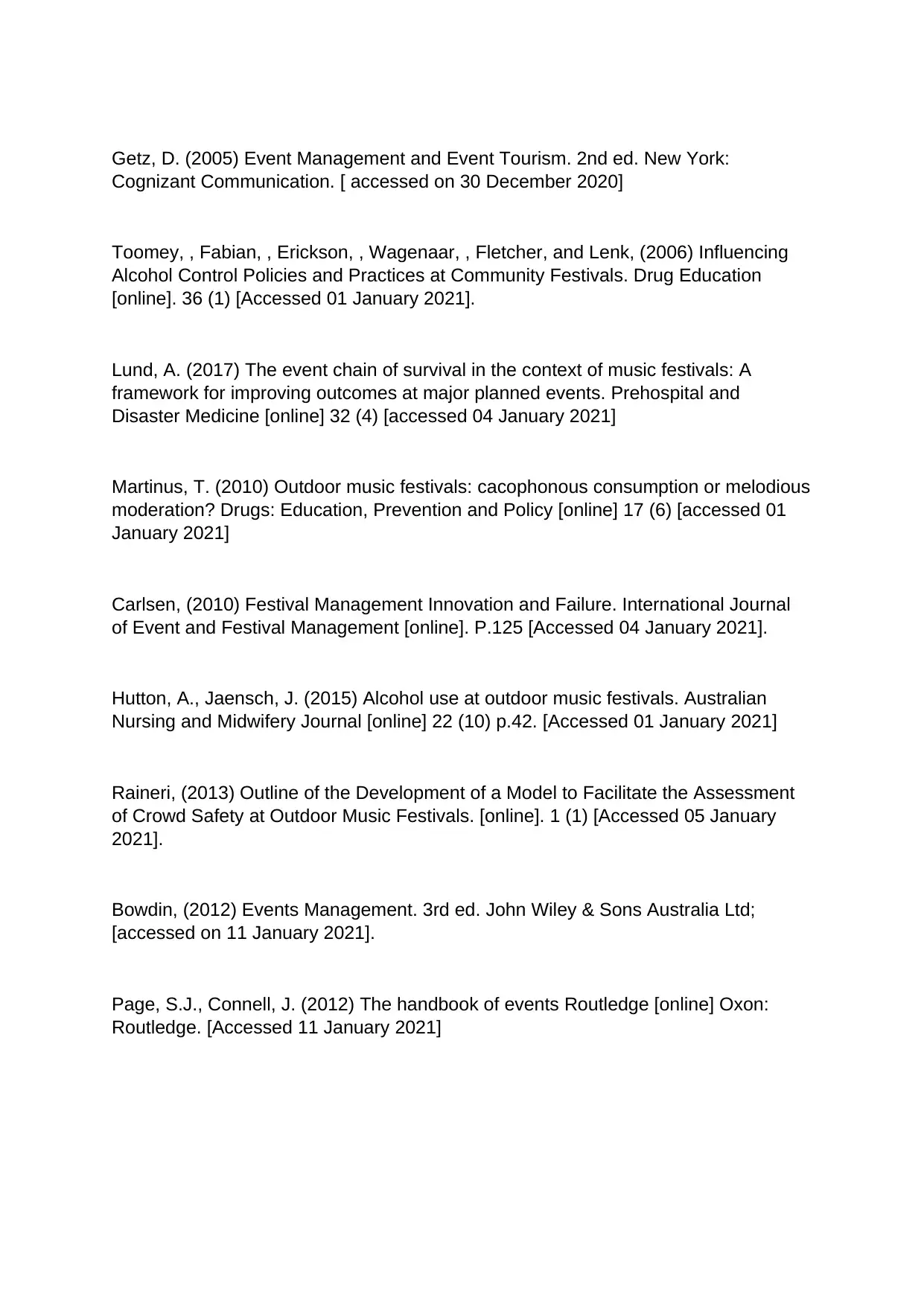Rio Owen - UMKDN8-15-1: Substance and Intoxication at Music Festivals
VerifiedAdded on 2021/07/29
|4
|1913
|177
Report
AI Summary
This report, authored by Rio Owen, student ID 20028362, for the Events in Society module (UMKDN8-15-1), explores the significant impact of substance and intoxication use at music festivals. The report, approximately 1251 words, delves into the prevalence of alcohol and drug consumption at festivals, highlighting the social norms and potential health risks, including overdoses and fatalities. It examines crowd behavior, often exacerbated by substance use, and the management strategies employed by event organizers, such as risk assessments, medical support, and security measures including searches and drug testing. The analysis references various academic sources, emphasizing the need for further research to improve festival safety and mitigate the negative consequences of substance abuse, including crowd control, fatalities and injuries. The report emphasizes the importance of understanding the complex interplay between festival environments, attendee behavior, and the role of substances in shaping the overall festival experience. It concludes by underscoring the need for more research and improved safety measures to prevent individuals from over-intoxication and create safer festival environments.

Rio Owen- student ID: 20028362
Events in society- UMKDN8-15-1
Word count: 1251
The Effects of Substance and Intoxication use at Music Festivals.
Introduction
Festivals are universal and occupy a special place in society and culture. Festivals
defined by (Getz 2010) are “a sacred or profane time of celebration, marked by
special observances.” Festivals often celebrate community values, ideologies,
identity, and continuity. Large music events, such as music festivals, attract large
numbers of visitors according to (Kristin Feltmann 2019). Examples include the
music festivals Glastonbury (175,000 people) and Tomorrowland (185,000 people) in
Europe and the Coachella Valley music and art festival (125,000 people) in the US.
(Feltmann, Elgán and Gripenberg, 2019, p.2) suggest that Music festivals are arenas
where young people socialize, and alcohol drinking is often considered a part of the
festival experience. As well as substance abuse with many people experimenting
and trying drugs for the first time at festivals. To add to this, Johnson, et al (2009.
P.213) states that music festivals seem to be the most influenced by substance and
alcohol abuse. The impact of being intoxicated have major consequences, including
bad crowd behaviour, overdosing and criminal activity (Getz, 2005). This literature
review will be exploring consequences of substance and intoxication abuse, as well
as how crowds and attendees are managed.
Drugs and alcohol at music festivals
Festivals are often highly anticipated events, seen as a break from normal life, and
can provide an occasion for alcohol and drug use (Borlagdan, Freeman, Duvnjak,
Bywood, & Roche, 2010; Luckman, 2003). The consumption of licit and illicit
substances is an important phenomenon that has been connected with nightlife and
festivals and has received widespread attention (Tina Van Havere 2009). As
reported by Mackellar, antisocial behaviour is looked upon to be associated with
excessive drug and alcohol consumption. (2014), As music festivals and raves have
grown more popular in recent years, so has music festival drug culture. Festival
drugs, such as MDMA and LSD, are a big part of the festival experience for many
people. (Lauren Brande, 2019.) Alcohol is often used to celebrate, Hutton and
Jaensch (2015, p.42) suggest that the consumption of alcohol is considered a social
norm, suggesting that it is almost expected of attendees to participate in drinking.
Alcohol use is associated with many public health problems including traffic crashes,
violence, sexual assaults, and sexually transmitted diseases (Zawacki 2005). Also,
Despite the best efforts of event producers and on-site medical teams, there are
sometimes serious illnesses, life-threatening injuries, and fatalities related to music
Events in society- UMKDN8-15-1
Word count: 1251
The Effects of Substance and Intoxication use at Music Festivals.
Introduction
Festivals are universal and occupy a special place in society and culture. Festivals
defined by (Getz 2010) are “a sacred or profane time of celebration, marked by
special observances.” Festivals often celebrate community values, ideologies,
identity, and continuity. Large music events, such as music festivals, attract large
numbers of visitors according to (Kristin Feltmann 2019). Examples include the
music festivals Glastonbury (175,000 people) and Tomorrowland (185,000 people) in
Europe and the Coachella Valley music and art festival (125,000 people) in the US.
(Feltmann, Elgán and Gripenberg, 2019, p.2) suggest that Music festivals are arenas
where young people socialize, and alcohol drinking is often considered a part of the
festival experience. As well as substance abuse with many people experimenting
and trying drugs for the first time at festivals. To add to this, Johnson, et al (2009.
P.213) states that music festivals seem to be the most influenced by substance and
alcohol abuse. The impact of being intoxicated have major consequences, including
bad crowd behaviour, overdosing and criminal activity (Getz, 2005). This literature
review will be exploring consequences of substance and intoxication abuse, as well
as how crowds and attendees are managed.
Drugs and alcohol at music festivals
Festivals are often highly anticipated events, seen as a break from normal life, and
can provide an occasion for alcohol and drug use (Borlagdan, Freeman, Duvnjak,
Bywood, & Roche, 2010; Luckman, 2003). The consumption of licit and illicit
substances is an important phenomenon that has been connected with nightlife and
festivals and has received widespread attention (Tina Van Havere 2009). As
reported by Mackellar, antisocial behaviour is looked upon to be associated with
excessive drug and alcohol consumption. (2014), As music festivals and raves have
grown more popular in recent years, so has music festival drug culture. Festival
drugs, such as MDMA and LSD, are a big part of the festival experience for many
people. (Lauren Brande, 2019.) Alcohol is often used to celebrate, Hutton and
Jaensch (2015, p.42) suggest that the consumption of alcohol is considered a social
norm, suggesting that it is almost expected of attendees to participate in drinking.
Alcohol use is associated with many public health problems including traffic crashes,
violence, sexual assaults, and sexually transmitted diseases (Zawacki 2005). Also,
Despite the best efforts of event producers and on-site medical teams, there are
sometimes serious illnesses, life-threatening injuries, and fatalities related to music
Paraphrase This Document
Need a fresh take? Get an instant paraphrase of this document with our AI Paraphraser

festival attendance. Drug overdoses are commonly reported at music festivals. There
have been more than 700 deaths at music festivals in the last 15 years; deaths are
related primarily to trauma and substance use. (Lund 2017). Anyhow, a high number
of deaths are covered within the media but not within academic literature. This
shows that more research needs to be conducted, more questions need to be asked.
(T. Martinus et al. p. 796) quoted, “the creation of a festival atmosphere, loud popular
music, the search for temporary freedom from the restraints imposed by work or
study.” This suggests festival attendees use their ticket to escape their reality for a
short while. Which could be seen as somewhat justifiable on a temporary occasion.
Event audience behaviour
Music festivals are regularly associated with rowdy, disruptive behaviour, also known
as “anti-social behaviour”. It goes without saying that drugs and alcohol often play a
big part in these types of behaviours. One example of anti-social behaviour within a
festival is the Gothenburg Party, a Swedish Festival, talked about by Carlsen, et al, it
was an open festival with no entrance fee. The vision was to create an ongoing
atmosphere of celebration of city life in Gothenburg for all citizens. Despite this vision
it did not go to plan, alcoholic beverages, combined with the vision to create a party
atmosphere for older and young people resulted in alcohol-induced anti-social
behaviour by youngsters. This behaviour gave the festival a negative perspective,
with Gothenburg residents came to consider the festival as a “booze up for
teenagers ending up being sick and falling asleep in our parks.” (Carlsen, et al. 2010,
p.125). At a festival behaviour such as mentioned above can have a tolerable effect,
it can deter people away from attending the particular festival again. It is clear that
drugs and alcohol play a huge part in crowd behaviours and peoples outlook on
festivals.
Management of Crowd behaviour
Event organizers have a responsibility to properly manage health and safety risks for
all attendees, staff, and contractors. When it comes to large events such as festivals.
Outdoor music festivals are increasingly common events in the summer for people in
many countries around the world. Evidence indicates that attendance is associated
with an increased risk of injury and death. A considerable proportion of crowd related
risks are attributed to irrational and high-risk behaviour by attendees. (Raineri, 2013.)
Conducting a risk assessment before the event takes place helps predict accidents
and problems which could occur (Bowden, et al. 2012). It is essential that enough
medial support is offered due to the large implications of intoxication. Suggested by
Page and Connell (2012), alcohol and drug consumption heightens the workload of
both emergency services and onsite festival care. A music festival in Sweden
employed 40 “alcohol inspectors”, to identify intoxicated people around the festival,
their jobs were to talk to them and remind them to be sensible and look after
themselves whilst at the festival. In some cases, they would contact security staff
who could end up removing the individual from the festival, (Feltmann, Elgán and
have been more than 700 deaths at music festivals in the last 15 years; deaths are
related primarily to trauma and substance use. (Lund 2017). Anyhow, a high number
of deaths are covered within the media but not within academic literature. This
shows that more research needs to be conducted, more questions need to be asked.
(T. Martinus et al. p. 796) quoted, “the creation of a festival atmosphere, loud popular
music, the search for temporary freedom from the restraints imposed by work or
study.” This suggests festival attendees use their ticket to escape their reality for a
short while. Which could be seen as somewhat justifiable on a temporary occasion.
Event audience behaviour
Music festivals are regularly associated with rowdy, disruptive behaviour, also known
as “anti-social behaviour”. It goes without saying that drugs and alcohol often play a
big part in these types of behaviours. One example of anti-social behaviour within a
festival is the Gothenburg Party, a Swedish Festival, talked about by Carlsen, et al, it
was an open festival with no entrance fee. The vision was to create an ongoing
atmosphere of celebration of city life in Gothenburg for all citizens. Despite this vision
it did not go to plan, alcoholic beverages, combined with the vision to create a party
atmosphere for older and young people resulted in alcohol-induced anti-social
behaviour by youngsters. This behaviour gave the festival a negative perspective,
with Gothenburg residents came to consider the festival as a “booze up for
teenagers ending up being sick and falling asleep in our parks.” (Carlsen, et al. 2010,
p.125). At a festival behaviour such as mentioned above can have a tolerable effect,
it can deter people away from attending the particular festival again. It is clear that
drugs and alcohol play a huge part in crowd behaviours and peoples outlook on
festivals.
Management of Crowd behaviour
Event organizers have a responsibility to properly manage health and safety risks for
all attendees, staff, and contractors. When it comes to large events such as festivals.
Outdoor music festivals are increasingly common events in the summer for people in
many countries around the world. Evidence indicates that attendance is associated
with an increased risk of injury and death. A considerable proportion of crowd related
risks are attributed to irrational and high-risk behaviour by attendees. (Raineri, 2013.)
Conducting a risk assessment before the event takes place helps predict accidents
and problems which could occur (Bowden, et al. 2012). It is essential that enough
medial support is offered due to the large implications of intoxication. Suggested by
Page and Connell (2012), alcohol and drug consumption heightens the workload of
both emergency services and onsite festival care. A music festival in Sweden
employed 40 “alcohol inspectors”, to identify intoxicated people around the festival,
their jobs were to talk to them and remind them to be sensible and look after
themselves whilst at the festival. In some cases, they would contact security staff
who could end up removing the individual from the festival, (Feltmann, Elgán and

Gripenberg, 2019). At every festival police and security services are deployed in
order to prohibit drug use and the sales of drugs and unlicenced alcohol. Commonly,
upon entry to a festival, individuals get searched to check for drugs and alcohol, by
doing this it reduces the risk of substances getting into the festival grounds and
campsites. Despite these efforts according to Page and Connell (2012), these
policing methods can be seen as ineffective, and “in some cases may increase
harm” as in the past attendees who are afraid and do not want of being caught have
consumed all of their drugs at one time. This obviously can lead to horrific fatal
consequences. In 2018 Bestival provided drug testing in attempt to prevent deaths,
People who arrived at the festival in Dorset were all able to test their drugs safely to
reveal its strength in a bid to reduce deaths and the testing allowed people the
opportunity to make informed decisions about what they chose to consume.
Conclusion
From the literature provided, it is indisputable that drugs and alcohol have a hugely
tolerable affect at events such as music festivals. It is obvious that the impact of
drugs within the music festival environment is negative due to the fact it causes
fatalities, high risk injuries and puts many people in a vulnerable state. However, in
average day to day life drinking alcohol is deemed normal but as seen in the
literature provided festival attendees tend to take it too far and drink way over their
limit and become high intoxicated. And at festivals there is a limit on how much staff
and security can do to stop this from happening. Due to the lack of research
regarding fatalities it can be hard for event organisers to learn from past issues and
try to figure out what is the best alternative in the future for better outcomes at
festivals. More research needs to be conducted in order to prevent individuals from
taking them selves over their limits and to make the festival environment safer.
References
Getz, (2010) Developing a Framework and Priorities for Comparative and Cross-
cultural Research. Festival Management Studies [online]. 1, p. 2. [Accessed 05
January 2021].
Feltmann, (2019) High Levels of Alcohol Intoxication and Strong Support for
Restrictive Alcohol Policies Among Music Festival Visitors. [online]. 1, p. 2.
[Accessed 04 January 2021].
Johnson, M.B., Voas, R.A., Miller, B.A., Holder, H.D. (2009) Predicting drug use at
Electronic Music Dance Events: self-reports and biological measurement. Evaluation
Review [online] 33 (3) pp.212-213. [ accessed 03 January 2021]
order to prohibit drug use and the sales of drugs and unlicenced alcohol. Commonly,
upon entry to a festival, individuals get searched to check for drugs and alcohol, by
doing this it reduces the risk of substances getting into the festival grounds and
campsites. Despite these efforts according to Page and Connell (2012), these
policing methods can be seen as ineffective, and “in some cases may increase
harm” as in the past attendees who are afraid and do not want of being caught have
consumed all of their drugs at one time. This obviously can lead to horrific fatal
consequences. In 2018 Bestival provided drug testing in attempt to prevent deaths,
People who arrived at the festival in Dorset were all able to test their drugs safely to
reveal its strength in a bid to reduce deaths and the testing allowed people the
opportunity to make informed decisions about what they chose to consume.
Conclusion
From the literature provided, it is indisputable that drugs and alcohol have a hugely
tolerable affect at events such as music festivals. It is obvious that the impact of
drugs within the music festival environment is negative due to the fact it causes
fatalities, high risk injuries and puts many people in a vulnerable state. However, in
average day to day life drinking alcohol is deemed normal but as seen in the
literature provided festival attendees tend to take it too far and drink way over their
limit and become high intoxicated. And at festivals there is a limit on how much staff
and security can do to stop this from happening. Due to the lack of research
regarding fatalities it can be hard for event organisers to learn from past issues and
try to figure out what is the best alternative in the future for better outcomes at
festivals. More research needs to be conducted in order to prevent individuals from
taking them selves over their limits and to make the festival environment safer.
References
Getz, (2010) Developing a Framework and Priorities for Comparative and Cross-
cultural Research. Festival Management Studies [online]. 1, p. 2. [Accessed 05
January 2021].
Feltmann, (2019) High Levels of Alcohol Intoxication and Strong Support for
Restrictive Alcohol Policies Among Music Festival Visitors. [online]. 1, p. 2.
[Accessed 04 January 2021].
Johnson, M.B., Voas, R.A., Miller, B.A., Holder, H.D. (2009) Predicting drug use at
Electronic Music Dance Events: self-reports and biological measurement. Evaluation
Review [online] 33 (3) pp.212-213. [ accessed 03 January 2021]
⊘ This is a preview!⊘
Do you want full access?
Subscribe today to unlock all pages.

Trusted by 1+ million students worldwide

Getz, D. (2005) Event Management and Event Tourism. 2nd ed. New York:
Cognizant Communication. [ accessed on 30 December 2020]
Toomey, , Fabian, , Erickson, , Wagenaar, , Fletcher, and Lenk, (2006) Influencing
Alcohol Control Policies and Practices at Community Festivals. Drug Education
[online]. 36 (1) [Accessed 01 January 2021].
Lund, A. (2017) The event chain of survival in the context of music festivals: A
framework for improving outcomes at major planned events. Prehospital and
Disaster Medicine [online] 32 (4) [accessed 04 January 2021]
Martinus, T. (2010) Outdoor music festivals: cacophonous consumption or melodious
moderation? Drugs: Education, Prevention and Policy [online] 17 (6) [accessed 01
January 2021]
Carlsen, (2010) Festival Management Innovation and Failure. International Journal
of Event and Festival Management [online]. P.125 [Accessed 04 January 2021].
Hutton, A., Jaensch, J. (2015) Alcohol use at outdoor music festivals. Australian
Nursing and Midwifery Journal [online] 22 (10) p.42. [Accessed 01 January 2021]
Raineri, (2013) Outline of the Development of a Model to Facilitate the Assessment
of Crowd Safety at Outdoor Music Festivals. [online]. 1 (1) [Accessed 05 January
2021].
Bowdin, (2012) Events Management. 3rd ed. John Wiley & Sons Australia Ltd;
[accessed on 11 January 2021].
Page, S.J., Connell, J. (2012) The handbook of events Routledge [online] Oxon:
Routledge. [Accessed 11 January 2021]
Cognizant Communication. [ accessed on 30 December 2020]
Toomey, , Fabian, , Erickson, , Wagenaar, , Fletcher, and Lenk, (2006) Influencing
Alcohol Control Policies and Practices at Community Festivals. Drug Education
[online]. 36 (1) [Accessed 01 January 2021].
Lund, A. (2017) The event chain of survival in the context of music festivals: A
framework for improving outcomes at major planned events. Prehospital and
Disaster Medicine [online] 32 (4) [accessed 04 January 2021]
Martinus, T. (2010) Outdoor music festivals: cacophonous consumption or melodious
moderation? Drugs: Education, Prevention and Policy [online] 17 (6) [accessed 01
January 2021]
Carlsen, (2010) Festival Management Innovation and Failure. International Journal
of Event and Festival Management [online]. P.125 [Accessed 04 January 2021].
Hutton, A., Jaensch, J. (2015) Alcohol use at outdoor music festivals. Australian
Nursing and Midwifery Journal [online] 22 (10) p.42. [Accessed 01 January 2021]
Raineri, (2013) Outline of the Development of a Model to Facilitate the Assessment
of Crowd Safety at Outdoor Music Festivals. [online]. 1 (1) [Accessed 05 January
2021].
Bowdin, (2012) Events Management. 3rd ed. John Wiley & Sons Australia Ltd;
[accessed on 11 January 2021].
Page, S.J., Connell, J. (2012) The handbook of events Routledge [online] Oxon:
Routledge. [Accessed 11 January 2021]
1 out of 4
Related Documents
Your All-in-One AI-Powered Toolkit for Academic Success.
+13062052269
info@desklib.com
Available 24*7 on WhatsApp / Email
![[object Object]](/_next/static/media/star-bottom.7253800d.svg)
Unlock your academic potential
Copyright © 2020–2025 A2Z Services. All Rights Reserved. Developed and managed by ZUCOL.



